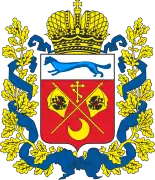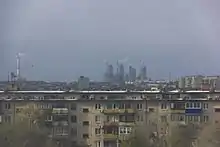Orenburg Oblast
Orenburg Oblast (Russian: Оренбургская область, Orenburgskaya oblast) is a federal subject of Russia (an oblast). Its administrative center is the city of Orenburg. From 1938 to 1957, it bore the name Chkalov Oblast (Чка́ловская о́бласть) in honor of Valery Chkalov. Population: 1,862,767 (2021 Census).[9]

Orenburg Oblast | |
|---|---|
| Оренбургская область | |
 Flag  Coat of arms | |
 | |
| Coordinates: 52°08′N 55°36′E | |
| Country | Russia |
| Federal district | Volga[1] |
| Economic region | Urals[2] |
| Administrative center | Orenburg |
| Government | |
| • Body | Legislative Assembly |
| • Governor | Denis Pasler[3] |
| Area | |
| • Total | 123,702 km2 (47,762 sq mi) |
| • Rank | 29th |
| Population | |
| • Total | 1,862,767 |
| • Estimate (2018)[6] | 1,977,720 |
| • Rank | 24th |
| • Density | 15/km2 (39/sq mi) |
| • Urban | 59.7% |
| • Rural | 40.3% |
| Time zone | UTC+5 (MSK+2 |
| ISO 3166 code | RU-ORE |
| License plates | 56, 156 |
| OKTMO ID | 53000000 |
| Official languages | Russian[8] |
| Website | http://www.orb.ru/ |
Geography
Orenburg Oblast's internal borders are with the republics of Bashkortostan and Tatarstan to the north, Chelyabinsk Oblast to the north-east, and with Samara and Saratov oblasts to the west. Orenburg Oblast also shares an international border with Kazakhstan to the east and south. The oblast is situated on the boundary between Europe and Asia. The majority of its territory lies west of the continental divide in European Russia and smaller sections in the east situated on the Asian side of the divide. The most important river of the oblast is the Ural and the largest lake Shalkar-Yega-Kara. Orenburg is traversed by the northeasterly line of equal latitude and longitude. The highest point of the oblast is 668 m (2,192 ft) high Nakas (mountain).[10]
Administrative divisions
Demographics
Population: 1,862,767 (2021 Census);[9] 2,033,072 (2010 Census);[11] 2,179,551 (2002 Census);[12] 2,174,459 (1989 Census).[13]
Ethnic composition (2021)[14]
| Ethnic group | Population | Percentage |
|---|---|---|
| Russians | 1,380,674 | 79.3% |
| Tatars | 116,605 | 6.7% |
| Kazakhs | 107,734 | 6.2% |
| Bashkirs | 36,181 | 2.1% |
| Mordvins | 18,300 | 1.1% |
| Ukrainians | 16,639 | 1.0% |
| Others | 65,056 | 3.7% |
| Ethnicity not stated | 121,578 | — |
Vital statistics for 2022:[15][16]
- Births: 16,216 (8.4 per 1,000)
- Deaths: 25,590 (13.3 per 1,000)
Total fertility rate (2022):[17]
1.46 children per woman
Life expectancy (2021):[18]
Total — 68.21 years (male — 63.91, female — 72.48)
Settlements
Largest cities or towns in Orenburg Oblast 2010 Russian Census | |||||||||
|---|---|---|---|---|---|---|---|---|---|
| Rank | Administrative Division | Pop. | |||||||
_-_panoramio.jpg.webp) Orenburg  Orsk |
1 | Orenburg | Orenburgsky District | 548,331 |  Novotroitsk .jpg.webp) Buzuluk | ||||
| 2 | Orsk | City of oblast significance of Orsk | 239,800 | ||||||
| 3 | Novotroitsk | Town of oblast significance of Novotroitsk | 98,173 | ||||||
| 4 | Buzuluk | Buzuluksky District | 82,904 | ||||||
| 5 | Buguruslan | Buguruslansky District | 49,741 | ||||||
| 6 | Gay | Gaysky District | 38,301 | ||||||
| 7 | Sorochinsk | Sorochinsky District | 29,249 | ||||||
| 8 | Sol-Iletsk | Sol-Iletsky District | 28,377 | ||||||
| 9 | Mednogorsk | Town of oblast significance of Mednogorsk | 27,292 | ||||||
| 10 | Kuvandyk | Kuvandyksky District | 26,169 | ||||||
Religion
As of a 2012 survey,[19] 40.2% of the population of Orenburg Oblast adheres to the Russian Orthodox Church, 3% declare themselves to be generic nondenominational Christians (excluding the Protestant definition), 2% are Orthodox Christian believers who do not belong to any church or belong to non-Russian Orthodox churches. Muslims constitute 13% of the population. 3% of the population are followers of the Slavic native faith (Rodnovery), 6.8% are followers of other religions or did not give an answer to the survey. In addition, 20% of the population declares to be "spiritual but not religious" and 12% to be atheist.[19]
Economy
Orenburg Oblast is one of the major agricultural areas of Russia. Its climate is favorable to farming with a humid spring, dry summer and many sunny days, which make perfect conditions for cultivating hard wheat and rye, sunflowers, potatoes, peas, beans, corn, and gourds.
The range of the oblast's export commodities includes oil and oil products, gas and gas produced products, rolled ferrous and non-ferrous metals, nickel, asbestos, chromium compounds, rough copper, electric engines, and radiators, which are used to make products from the machine-building industry.
See also
References
- Президент Российской Федерации. Указ №849 от 13 мая 2000 г. «О полномочном представителе Президента Российской Федерации в федеральном округе». Вступил в силу 13 мая 2000 г. Опубликован: "Собрание законодательства РФ", No. 20, ст. 2112, 15 мая 2000 г. (President of the Russian Federation. Decree #849 of May 13, 2000 On the Plenipotentiary Representative of the President of the Russian Federation in a Federal District. Effective as of May 13, 2000.).
- Госстандарт Российской Федерации. №ОК 024-95 27 декабря 1995 г. «Общероссийский классификатор экономических регионов. 2. Экономические районы», в ред. Изменения №5/2001 ОКЭР. (Gosstandart of the Russian Federation. #OK 024-95 December 27, 1995 Russian Classification of Economic Regions. 2. Economic Regions, as amended by the Amendment #5/2001 OKER. ).
- Official website of Orenburg Oblast. Governor of Orenburg Oblast (in Russian)
- "Сведения о наличии и распределении земель в Российской Федерации на 01.01.2019 (в разрезе субъектов Российской Федерации)". Federal Service for State Registration, Cadastre and Cartography. Archived from the original on 9 February 2022. Retrieved 29 August 2023.
- "Оценка численности постоянного населения по субъектам Российской Федерации". Federal State Statistics Service. Retrieved 1 September 2022.
- "26. Численность постоянного населения Российской Федерации по муниципальным образованиям на 1 января 2018 года". Federal State Statistics Service. Retrieved 23 January 2019.
- "Об исчислении времени". Официальный интернет-портал правовой информации (in Russian). 3 June 2011. Retrieved 19 January 2019.
- Official throughout the Russian Federation according to Article 68.1 of the Constitution of Russia.
- Russian Federal State Statistics Service. Всероссийская перепись населения 2020 года. Том 1 [2020 All-Russian Population Census, vol. 1] (XLS) (in Russian). Federal State Statistics Service.
- Google Earth
- Russian Federal State Statistics Service (2011). Всероссийская перепись населения 2010 года. Том 1 [2010 All-Russian Population Census, vol. 1]. Всероссийская перепись населения 2010 года [2010 All-Russia Population Census] (in Russian). Federal State Statistics Service.
- Russian Federal State Statistics Service (21 May 2004). Численность населения России, субъектов Российской Федерации в составе федеральных округов, районов, городских поселений, сельских населённых пунктов – районных центров и сельских населённых пунктов с населением 3 тысячи и более человек [Population of Russia, Its Federal Districts, Federal Subjects, Districts, Urban Localities, Rural Localities—Administrative Centers, and Rural Localities with Population of Over 3,000] (XLS). Всероссийская перепись населения 2002 года [All-Russia Population Census of 2002] (in Russian).
- Всесоюзная перепись населения 1989 г. Численность наличного населения союзных и автономных республик, автономных областей и округов, краёв, областей, районов, городских поселений и сёл-райцентров [All Union Population Census of 1989: Present Population of Union and Autonomous Republics, Autonomous Oblasts and Okrugs, Krais, Oblasts, Districts, Urban Settlements, and Villages Serving as District Administrative Centers]. Всесоюзная перепись населения 1989 года [All-Union Population Census of 1989] (in Russian). Институт демографии Национального исследовательского университета: Высшая школа экономики [Institute of Demography at the National Research University: Higher School of Economics]. 1989 – via Demoscope Weekly.
- "Национальный состав населения". Federal State Statistics Service. Retrieved 29 August 2023.
- "Information on the number of registered births, deaths, marriages and divorces for January to December 2022". ROSSTAT. Archived from the original on 2 March 2023. Retrieved 21 February 2023.
- "Birth rate, mortality rate, natural increase, marriage rate, divorce rate for January to December 2022". ROSSTAT. Archived from the original on 2 March 2023. Retrieved 21 February 2023.
- Суммарный коэффициент рождаемости [Total fertility rate]. Russian Federal State Statistics Service (in Russian). Archived from the original (XLSX) on 10 August 2023. Retrieved 10 August 2023.
- "Демографический ежегодник России" [The Demographic Yearbook of Russia] (in Russian). Federal State Statistics Service of Russia (Rosstat). Retrieved 1 June 2022.
- "Arena: Atlas of Religions and Nationalities in Russia". Sreda, 2012.
- 2012 Arena Atlas Religion Maps. "Ogonek", № 34 (5243), 27 August 2012. Retrieved 21 April 2017. Archived.
External links
- Kropotkin, Peter Alexeivitch; Bealby, John Thomas (1911). . Encyclopædia Britannica. Vol. 20 (11th ed.). p. 252.